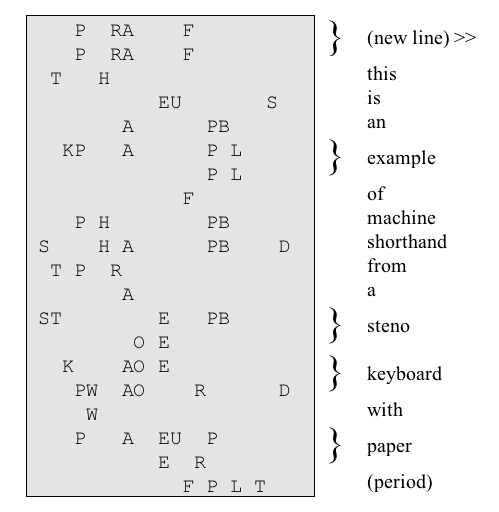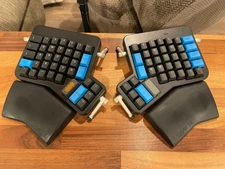What if you could type x3 faster after only a month of learning, would not that be nice! Well, you can do that, but within limitations. The method is called stenography. It is a dying art, being slowly replaced by cameras and AI. It takes a long time to become a court reporter, yet you can master the basic skill very quickly.
Speedwriting is not actually about typing skills, but it can definitely benefit from faster typing. Check out my speedwriting masterclass course. You don’t have to pay the full price. Just contact [email protected] and ask for a significant discount. We guarantee your satisfaction!
The easy way
The easiest method of stenography is called stenographic “speedwriting”. Do not confuse it with what I call speedwriting in my classes as I am more interested in intellectual exercise than in technical recording. Yet, seeing a trained master like a stenographer perform his job is quite an experience.
Stenographers noticed that the text we type is intelligible even without certain letters and punctuation signs. Our language is extremely redundant. You throw away the letters you do not absolutely need, replace “the” with a point and you have the basic stenography.
Consider this:

You can probably read and understand the text without further training.
The origins of stenography
Notice that in Hebrew we do not write vowels, which makes me think that Hebrew is stenographic by design. And yes, we understand everything without vowels, after about a year of training. Yet Hebrew is a living language, not a shortcut for scribes in a hurry.
In Greek, steno means narrow and graphia means writing, so stenography and shorthand are literally the same things. The words can be used interganginbly.
The earliest known indication of shorthand systems is from the Parthenon in Ancient Greece, where a mid-4th century BCE inscribed marble slab was found. This shows a writing system primarily based on vowels, using certain modifications to indicate consonants. Various methods were used by Romans as well as in imperial China where cursive symbols were used.
In 1950 some scholars in Catalonia acquired a so-called Monserat codex dating to the third century AD. This codex is probably the first surviving dictionary of words with their stenographic abbreviation.
Speedwriting stenography as we use was developed in 1937 by Emma Dearborn. It was developed by a teacher as an easy method to master. The predating methods were much faster to write, but also more complex to learn. The greatness of her approach was in its simplicity
How does shorthand work?
The early shorthand systems introduced hieroglyphic systems, which represented thousands of words with very few distinct quill strokes each. 16th-century scholars developed a different, easier to write alphabets. It was continuosly improved until in 1837 an English teacher Isaac Pitman perfected the system using phonemic orthography. Basically what you hear is what you write using a special easy-to-write alphabet.
For my eyes, Pitman’s alphabet looks very much like modern Korean, where simple geometric shapes represent several similarly sounding phonemes each. A phoneme is a sort of a pair of a consonant and a vowel. Only English is not built this way, and looks very weird when written like this. It actually looks But this method is very fast. The record for fast writing with Pitman shorthand is 350 wpm during a two-minute test by Nathan Behrin in 1922.
Pitman’s alphabet is more friendly for fountain pens. Today court reporters are more likely to use a pencil. The fastest shorthand today is probably Gregg’s which is very similar to Pitman’s with different and slightly more cursive symbols. Gregg shorthand has been adapted to several languages, including Afrikaans, Esperanto, French, German, Hebrew, Irish, Italian, Japanese, Polish, Portuguese, Russian, Spanish, Catalan, Thai, and Tagalog. The Mandarin Chinese version slightly modified the original system, under the name Beifang Suji (‘Northern Shorthand)’. With a few customizations, it can be adapted to nearly any language.
A small taste of Pitman’s

In modern Pitman script there very few hierogliphic logograms

Pitman shorthand uses straight strokes and quarter-circle strokes, in various orientations, to represent consonant sounds.
The predominant way of indicating vowels is to use light or heavy dots, dashes, or other special marks drawn close to the consonant. Another feature of Pitman’s shorthand allows most vowels to be omitted in order to speed up the process of writing. As mentioned above, each vowel is written next to the consonant stroke at the beginning, middle or end of the stroke.
To be honest, when I first saw this script it looked like a strange combo of Japanese and dementia.
And what can I do with that?
To be honest, nobody in his right mind will understand your Pitman or Gregg stenography unless he was trained in stenography. The basic idea was making the notes quickly during a meeting, and then slowly translating them into a full transcript in the office after the meeting. Today, AI can possibly handle the bulk of the rewrite, but you will need to correct its errors manually. Only, if you use AI, you do not need steno writers or typists: AI will handle everything.
Moreover, many trained stenographers rarely use handwritten notes possibly since 1930s. What do they use instead?
Stenotype
Just as ancient stenographers did not use available scripts, more modern typists do not use QWERTY keyboard. Their keyboards are strange and wonderful, perfectly suited for human hands. For me, they look like a mutilated accordion.

They do not bear letter markings, but a usual layout is

To play this strange almost musical instrument, the typists use chords of several letters pressed together.

I know, this sounds a bit crazy, but court reporter Mark Kislingbury (USA), a stenotype writer from Houston, Texas holds the record with 360 words per minute! That’s about x10 of what your current typing speed probably is.
If you think that professional steno keyboard can cost you, you may be right. Consider buying custom Ergodox. That will cost you around 200 dollars.

Here is an entire blog about the setup. Notice, it is not your standard keyboard.
iStenoPad training
With steno keyboard you will type much faster, but the learning curve will be steep and you may need some basic tinkering. If you play a piano and program, your learning curve might be not very bad.
Personally. I never was limited by my typing speed, at least not in English since 2010. My main limitation is the speed of ideation. So I do not want the absolute best, I want something easy to learn.
If you have an ipad, consider using a 20USD software called iStenPad. With it, your ipad is transformed into a steno keyboard. The app will also add dictionary, speed display, and customizable keys.

Back to speedwriting shorthand
So, why is speedwriting shorthand so alluring? You can master it easily! And it should roughly double your speed. Possibly after just six hours of learning and some hands-on practice.
How does it work? Put in Google “Pullis Speedwriting pdf” and get the third version of the speedwriting shorthand method. It was developed in 1980s. I added some adaptations for the QWERTY keyboard.
- vowels are included rather than omitted more often; “cheap” is written as cep
- the word “the” is indicated by a dot .
- period at the end of the sentence is written as a large diagonal stroke \
- the brief forms for it/at looks like an inverted diagonal stroke /
- the brief forms for is/his looks like coma ,
- the past tense of regular verbs is indicated with a hyphen on the line of writing
- past tense of a regular verb is indicated by a short horizontal stroke above the final letter of the root-word… On your keyboard consider _ after the letter…
- the “ch” sound is written with uppercase C
- the “sh” sound is written with a modified lowercase cursive s… On your keyboard consider $.
And then read a long speed writing dictionary of 4000 English words…
You will need to turn off your regular spellcheck and type/write like crazy. Once done, activate a macro that converts your text into regular text using a dictionary.
And you can combine it with your steno keyboard.
So why do I still type as I did?
Personally, I really NEED my spellchecker. I insert links as I write. Honestly, I often research on one of my other screens almost simultaneously. Most importantly, I do not have a real motivation to do that YET. However, you may want to try this methodology and write me a guest post!
Take this as a challenge…

Get 4 Free Sample Chapters of the Key To Study Book
Get access to advanced training, and a selection of free apps to train your reading speed and visual memory
